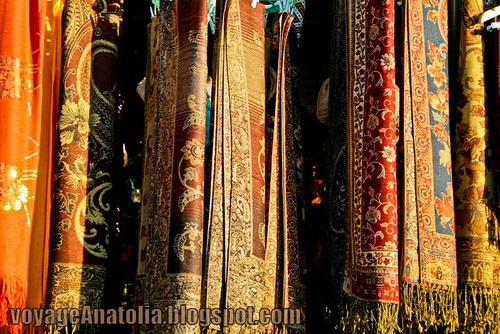
Silk Carpets, originally uploaded by voyageAnatolia.blogspot.com.
Fine Turkish silk carpets and rugs at Ankara.
Carpets, whether knotted or flat woven (hummas) are among the best known art forms produced by the Turks from time immemorial. There are environmental, sociological, economic, and religious reasons for the widespread art of carpet weaving among the Turkish people from Central Asia to Turkey.
The geographical regions where Turks have lived throughout the centuries lie in the temperate zone. Temperature fluctuations between day and night, summer and winter may vary greatly. Turks-nomadicor pastoral, agrarian or town-dwellers, living in tents or in sumptuous houses in large cities-have protected themselves from the extremes of the cold weather by covering the floors, and sometimes walls and doorways, with carpets. The carpets are always hand made of wool or sometimes cotton, with occasional additions of silk. These carpets are natural barriers against the cold. The flat woven kilims which are frequently embroidered are used as blankets, curtains, and covers over sofas or as cushion covers.
In general, Turks take their shoes off upon entering a house. Thus, the dust and dirt of the outdoors are not tracked inside.The floor coverings remain clean, and the inhabitants of the house, if need be, can comfortably rest on the floor. In the traditional households, women and girls take up carpet and kilim weaving as a hobby as well as a means of earning money. Even technological advances which promoted factory-made carpets could not hamper the production of rug weaving at cottage-industry level. Although synthetic dyes have been in use for the last 150 years, hand made carpets are still considered far superior to industrial carpeting.
Turkish carpets are among the most sought after household items all over the world. Their rich colors, warm tones, and extraordinary patterns with traditional motifs have contributed to the status that Turkish carpets have maintained since the 13th century. Marco Polo, who traveled through Anatolia in the late 13th century, commented on the beauty and artistry of the carpets. A number of carpets from this period, known as the Seljuk carpets, were discovered in several mosques in central Anatolia. These were under many layers of subsequently placed carpets. The Seljuk carpets are today in the museums in Konya and Istanbul. It is very exciting to imagine that we may be looking at the very same carpets that Marco Polo praised in the year 1272.
Turkish carpets in the 15th and 16th centuries are best known through European paintings. For example, in the works of Lotto (15th century Italian painter) and Holbein (16th century Germanpainter), Turkish carpets are seen under the feet of the Virgin Mary, or in secular paintings, on tables. In the 17th century, when the Netherlands became a powerful mercantile country, Turkish carpets graced many Dutch homes. The Dutch painter Vermeer represented Turkish carpets predominantly to indicate the high economic and social status of the persons in his paintings. Turkey carpets, as they were known, were too valuable to be put on floors, except under the feet of the Holy Mother and royalty.
Anyone who enters a mosque has to take off his/her shoes. The mosque is the common house of a Muslim community, therefore, shoes are cast off before the door. Moreover, the ritual of prayer requires the faithful to kneel and touch the ground with one s forehead in humility before God. There are no chairs or benches in a mosque, only carpets. A Turkish mosque is often covered from wall to wall with several layers of carpets.
The Turkish carpets have exuberant colors, motifs, and patterns. No two carpets are the same; each one is a creation from a new. Because traditionally women have woven the carpets, this is one art form that is rarely appreciated as being the work of a known or a specific artist. Nevertheless, the Turkish women silently continue to create some of the most stunning examples of works of art to be distributed all over Turkey and the world.